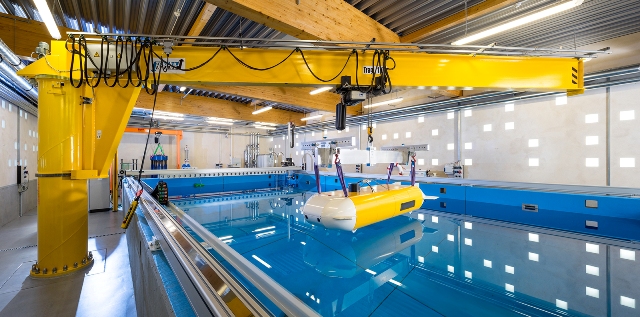Feb 2 2016
Autonomous underwater vehicles are essential for tasks such as exploring the seabed in search of oil or minerals. Fraunhofer researchers have designed the first robust, lightweight and powerful vehicle intended for series production.
 © Photo: Fraunhofer IOSB-AST.The underwater vehicle suspended above the maritime systems research platform with its slewing crane, portal system and (in the background on the left) pressure chamber.
© Photo: Fraunhofer IOSB-AST.The underwater vehicle suspended above the maritime systems research platform with its slewing crane, portal system and (in the background on the left) pressure chamber.
There has never been so much human activity in the depths of the oceans. Several thousand meters below the surface, oil companies are prospecting for new deposits and deep-sea mining companies are looking for valuable mineral resources. Then there are the thousands of kilometers of pipelines and submarine cables that need regular maintenance. Not to mention the marine scientists who would like to be able to use robust devices to survey large areas of the ocean floor. All these applications mean there is a growing demand for underwater exploration vehicles.
To meet this demand, researchers at the Fraunhofer Institute for Optronics, System Technologies and Image Exploitation IOSB in Ilmenau and Karlsruhe have designed a powerful autonomous underwater vehicle (AUV) capable of being manufactured in large numbers. Companies have been using AUVs for many years in deep-sea exploration missions. These untethered vehicles glide independently through the water collecting observation data, and make their own way back to the research vessel. Up to now, these have primarily been custom-built and very expensive. They have complicated structures, which makes them relatively difficult to handle by the crew on board the research vessel; for instance, accessing the batteries in order to replace them. It takes one hour to read the many terabytes of observation data out of the AUV’s onboard processor. What’s more, many of these vehicles are so heavy that only specially trained operators can place them in the water using the ship’s winch.
CAN bus system prevents cable spaghetti
The IOSB’s AUV overcomes all of these problems and will be on display at the Oceanology International exhibition (Booth H600) in London from March 15 to 17, 2016 and at the Hannover Messe trade fair from April 25 to 29, 2016 (Hall 2, Booth C16/C22). The vehicle called DEDAVE (Deep Diving AUV for Exploration) bears a certain resemblance to the space shuttle. The research team, led by project manager Professor Thomas Rauschenbach, has fitted it out with technologies not normally found in AUVs to date. To avoid the typical mess of cables, which was often a source of faults, they installed a CAN bus system like those found in every modern car. It consists of a slim cable to which all control devices and electric motors can be connected. “Many experts who visit our laboratory are amazed how neat and tidy DEDAVE looks on the inside,” says Rauschenbach. The advantage of having so few cables and connectors is that faults are avoided. New modules, sensors or test devices can also be connected quickly and easily to the standardized CAN bus. Batteries and data storage devices are held in place by a tough but simple latch mechanism, allowing them to be removed with a minimum of effort. There is no longer any need to download data from the processor.
Room for four AUVs in one shipping container
One of the strengths of the lightweight, 3.5-meter-long underwater vehicle is that it takes up very little space. Aboard a ship, AUVs are stored in standard shipping containers, which usually offer only enough room for one vehicle. “We, one the other hand, can fit four AUVs into the same container,” says Rauschenbach. “The advantage of having four vehicles available is that larger than usual areas of ocean can be surveyed in far less time.” Despite their small size, the AUVs still provide plenty of additional carrying space. The payload bay measures approximately one meter in length, which is sufficient for installing several different sensors for capturing ocean floor survey data.
The underwater vehicle is powered by eight batteries, each weighing 15 kilograms. A fast-release latch mechanism enables them to be removed and replaced with little effort. A fully charged battery holds enough power for up to 20 hours’ travel. The software for the sophisticated battery management system was specially developed by researchers at the Fraunhofer Institute for Silicon Technology ISIT in Itzehoe. In collaboration with the GEOMAR Helmholtz Center for Ocean Research, Kiel, and a Spanish research center, DEDAVE will go through deep sea testing off the coast of Gran Canaria in the coming weeks.